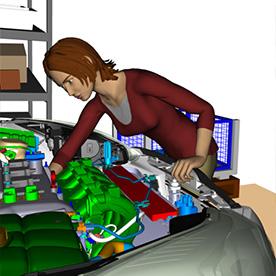November 26, 2015

Siemens and Georgia Institute of Technology are partnering to address limitations in the current additive manufacturing design-to-production chain in an applied research project as part of the federally backed America Makes program. It is part of a larger industrial technology research partnership between the two bodies.
According to Ulrich Raschke, director of Siemens' human simulation products, a cause of the gaps in the current additive manufacturing workflow, which has been referred to as the digital manufacturing chain by some in industry, is the result of traditional CAD and CAE tools not having the capabilities to realize AM's full potential.
Siemens has been trying to fill some of those gaps with its NX mechanical design software, adding design intelligence for so-called hybrid manufacturing process -- those that incorporate additive manufacturing with subtractive manufacturing such as machining. For NX, Rasche told Design News that Siemens is "developing modules that can enable better designs from additive manufacturing processes," accounting for manufacturing process constraints and impact on material properties.

The German industrial giant has a long history of partnering with academic institutions on advanced manufacturing research. It recently expanded its 20-year partnership with Georgia Tech to pursue manufacturing and design improvements through software. Siemens and Georgia Tech have partnered on a number of initiatives in recent years, including several government-funded collaborations. America Makes was the pilot program for the National Network for Manufacturing Innovation began by the government to propel applied research in a number of fields for US advanced manufacturing.
Siemens uses additive manufacturing internally for its industrial products. One particularly relevant application is expediting gas turbine repairs, according to Fred Villeneuve, manager of integrated design system in gas turbine engineering for Siemens Power and Gas.
READ MORE ARTICLES BY TRACEY SCHELMETIC ON DESIGN NEWS:
"For certain types of gas turbines, defective burner posts are simply reprinted, reducing repair times by as much as 90%," Villeneuve told Design News. "This type of application enables more complex part and component designs to be produced, which results in longer lifespan, lower cost, and better performance."
The second major project in the Siemens-Georgia Tech expanded partnership will be further development of Siemens PLM's Jack simulation software, a part of the company's Tecnomatix portfolio. Jack allows companies to use realistic avatars to simulate factory workspace processes and improve the design of factory floors and workstations.
Users of the industrial engineering tool can design for greater task efficiency, ergonomics, and safety for line workers. The new project with Georgia Tech aims to improve Jack through advanced analysis of geometric shapes and action optimization to make it easier to build simulations on a broader scale. The goal is to reduce worker fatigue and improve work instruction fulfillment.
A company might, for example, use simulations to ensure that an operator can exert the physical forces required for an engine hose installation, Raschke said.
"If an awkward posture is required due to other components being in the way of a good grip, reduced force capability may result," he said. "The Jack software can estimate what these forces are, and this information can be compared against the required forces for the hose installation. If the force is insufficient, then the specification for the hose connection may be changed, or the process may be changed."
Jack software will also be able to improve the placement and elevation of part containers. It can predict the number of steps and postures required to obtain a part and bring it to an assembly area. Work-cell layouts can be optimized for the time it takes to do a task and the worker's movements.
The final element of the expanded relationship is Siemens naming Georgia Tech a Center of Knowledge Interchange (CKI) partner for research and development. As a CKI ally, Georgia Tech joins an international group of eight research universities that includes the University of California, Berkeley in the US.
Tracey Schelmetic graduated from Fairfield University in Fairfield, Conn. and began her long career as a technology and science writer and editor at Appleton & Lange, the now-defunct medical publishing arm of Simon & Schuster. Later, as the editorial director of telecom trade journal Customer Interaction Solutions (today Customer magazine) she became a well-recognized voice in the contact center industry. Today, she is a freelance writer specializing in manufacturing and technology, telecommunications, and enterprise software.
Like reading Design News? Then have our content delivered to your inbox every day by registering with DesignNews.com and signing up for Design News Daily plus our other e-newsletters. Register here!

Design engineers and professionals, the West Coast's most important design, innovation, and manufacturing event, Pacific Design & Manufacturing, is taking place in Anaheim, Feb. 9-11, 2016. A Design News event, Pacific Design & Manufacturing is your chance to meet qualified suppliers, get hands-on access to the latest technologies, be informed from a world-class conference program, and expand your network. (You might even meet a Design News editor.) Learn more about Pacific Design & Manufacturing here.
About the Author(s)
You May Also Like





